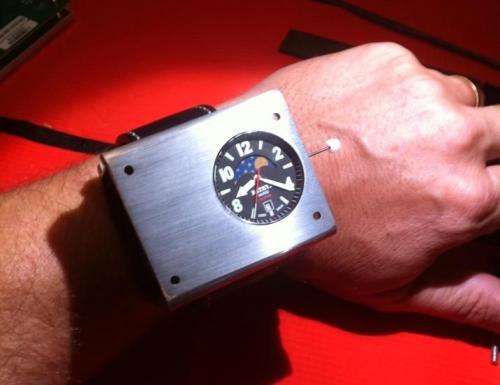October 2, 2013 weblog
Watch company develops wristwatch with its own atomic clock

Bathys Hawaii, a US-based watch company, has created the Cesium 133, a prototype wrist watch that has its own atomic clock. The fact that the clock is self-contained, integrated into the wristwatch, is the distinguishing factor. The clock does not need to collect information from an external source to keep accurate time, unlike watches using a government-generated radio signal as the external source. Bathys founder Dr. John Patterson and engineer George Talbot developed this watch. (German chemists Robert Bunsen and Gustav Kirchhoff discovered cesium in 1860 through flame spectroscopy. Cesium subsequently has been widely used in atomic clocks, and the first accurate cesium clock is credited to Louis Essen in 1955 at the UK National Physical Laboratory. The NPL is the UK's measurement institute for developing accurate measurement standards.)
The Bathys Cesium 133 wristwatch is reportedly capable of accuracy to one second in 1000 years according to a report in Watchuseek. Dr. Patterson is quoted in the report: "The technology found in this watch is something even a decade ago no one could imagine existing in such a small package." He said that "Within a single chip there is a laser, a heater, a sealed cavity of cesium gas, a microwave filter and a photodiode detector." He also said that, "Using the exact same principle of counting hyperfine lines of excited cesium 133 atoms used by the National Institute of Standards and Technology (NIST), our watch is able to achieve unprecedented levels of accuracy; on the order of 1 second per thousand years."
As for display, this is a traditional analog watch dial. The batteries are rechargeable lithium batteries. Goals are now to reduce the size and increase the battery life. When ready, a limited edition of 20 watches is planned for release. The estimated price of each Bathys Cesium 133 atomic clock watch is $12,000, according to the report.
A forum of responses to the atomic watch news went up on the Watchuseek site, with some respondents taking issue with the size. One comment was that the definition of wristwatch was undergoing a stretch and another remarked that it looked like a clock strapped on to a wrist, while other posts expressed interest in what the company was trying to achieve.
A response from "BathysHawaii" surfaced in the WatchuSeek forum with this to say: "It IS large...it's huge in fact. But this is just a proof-of-concept prototype. You can't get to the sleek watch we'd want to make until we made a rather crude version to test things such as integration, COM and power. There's still a long way to go—but the point is that we've got a genuine cesium atomic oscillator functioning on the arm for the first time ever. It blows me away frankly that we've done this."
More information:
www.watchuseek.com/news/bam-ba … watch-the-cesium-133
forums.watchuseek.com/f2/bam-b … um-133-a-921820.html
© 2013 Phys.org


















